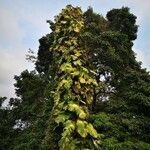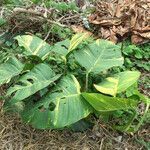Robust bole climber; feeder roots corky; internodes with longitudinal raised crests. Leaves: petiole to c. 70 cm long, sheathing for most of length, apically geniculate; sheath degrading to copious fibres; blade simple, oblong-ovate, entire in juveniles gradually becoming increasingly pinnatifid by fenestration in adult plants, rarely entire in adult plants, often with pin-prick holes near midrib, to c. 70 cm long, with up to c. 12 segments per side of midrib; segments (except apical and basal compound segments) each with 1 primary vein, obliquely truncate at apex; secondary venation reticulate. Inflorescences usually multiple, in an apical cluster; subtending bracts degrading like leaf sheath into multiple papery fibres; spathe c. 20 cm long, thick, greenish outside, dirty cream inside, opening boat-shaped, caducous; spadix subsessile, slightly shorter than spathe. Stigmas slit-like. Infructescence green, with distal parts of ovary shed in coherent plates revealing orange pulp.
An evergreen vine. It climbs to 6-50 m high. The stem is slender and fibrous but fleshy. The leaves are green and shiny. They are oval or sword shaped. The leaves can be 70 cm long by 40 cm wide and hang downwards. The form a point towards the tip. The leaves are deeply divided, although forms occur with entire leaves. The leaf stalk is about the same length as the leaf. The flowers are dense fleshy spikes. This is 15-20 cm long. The flower is surrounded by a large green boat shaped bract. The flower spikes contain both sexes where the female flowers are lower. These are followed by fruit. The berry is united into a composite red fruit.




